He had been a soldier once, high enough in rank to wear epaulettes and cufflinks. His roots probably went back to England or Scotland. Perhaps he had a family and a fine military record. No one is sure; his secrets were buried with him.
All that remains of the military man is spread out on a shelf in a brightly lit archeology lab outside Montreal. He has no name, just a number: 1A22.
The officer's skeleton was unearthed last year during routine road digging in the heart of downtown Montreal. Crews for Hydro-Québec were laying a power line beneath busy René Lévesque Boulevard when they came across something they'd suspected was below, but weren't sure where: the vestiges of an abandoned Protestant cemetery dating to the 19th century.
"We weren't certain if we were within the cemetery borders or not," says André Burroughs, an archeologist with Hydro-Québec who oversaw the work. "At first, we were surprised."
The discovery turned up the remains of 61 individuals, many of them just bones gathered in collective burial boxes. The remains underwent analysis by archeologists, who shared the results with The Globe and Mail this month.
They offer a glimpse into the story of a burial ground that served Montreal's growing Protestant population starting in 1799. By the mid-1800s the site no longer served its purpose, and the caskets of the wealthy were exhumed and re-interred. John Molson's remains were transferred to the new Mount Royal Cemetery on the lofty flanks of the mountain. Those of James McGill were reburied on the campus of the university he founded.
Others, like those of the officer, were simply left behind.
"You might think everyone was taken care of, but that's not the case," Mr. Burroughs says. "They were forgotten."
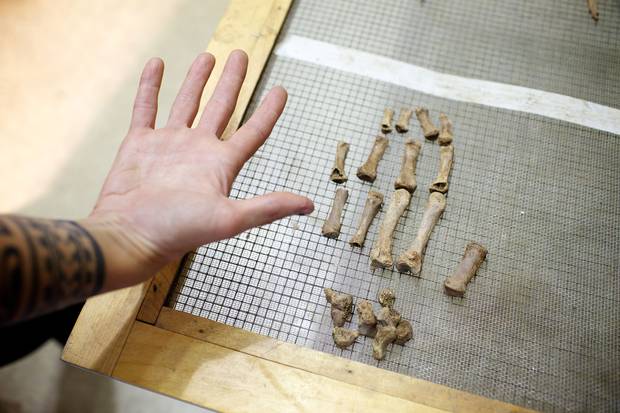
A bioarcheologist working on the project holds her hand alongside the bones from the military man’s right hand. The length of the man’s bones suggest he had lived into middle age before he died.
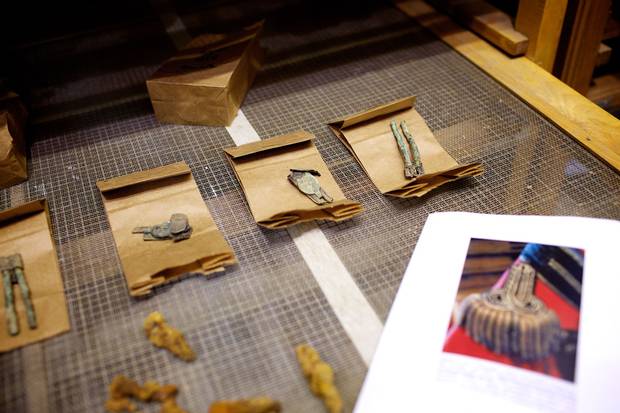
The military man was found with various buttons and metal pieces from shoulder decorations that suggest a high rank. The skeleton shows no signs of an injury in battle.
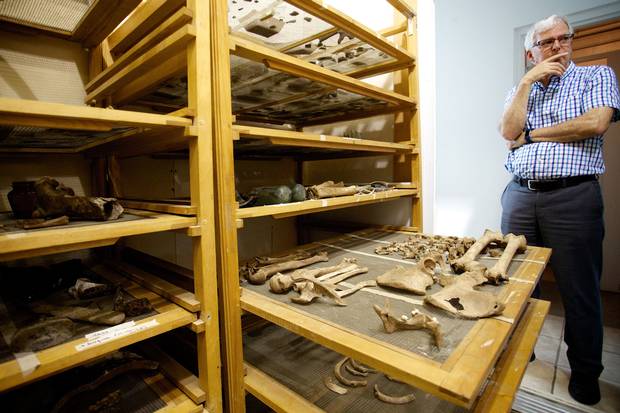
Hydro-Québec archeologist André Burroughs says the remains unearthed could end up at the Mount Royal Cemetery, which is where many caskets from the St. Lawrence Burial Ground – usually those of wealthy people – ended up when the site was abandoned.
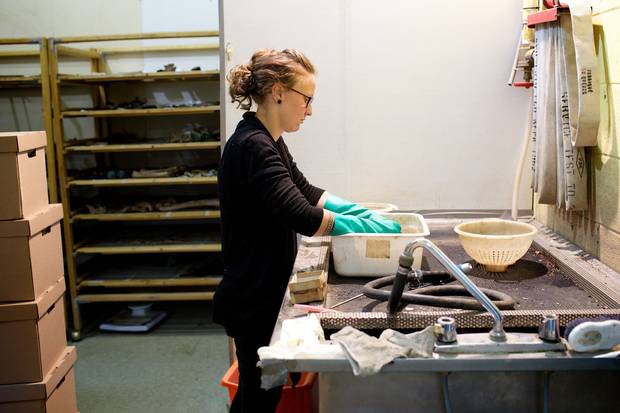
A bioarcheologist cleans items from various findings.
The St. Lawrence Burial Ground bore witness to a time when Montreal's English-speaking community was growing in size and influence after the advent of British rule in 1760. The city was still contained within the walls of what is now Old Montreal, and the new graveyard was built in the suburbs. Yet in no time, the site was overtaken by the thriving city around it. The cemetery closed, high-rises sprouted, cars turned the roadway into one of Montreal's most congested streets and throngs of pedestrians milled above ground. Most of the cemetery lies beneath Complexe Guy Favreau, a federal building at the corner of St. Urbain Street that went up in the mid-1980s.
Yet all along, the remains of the deceased lay silently beneath a city's feet.
"We imagine that everything was swept away and disappeared when we built something new," Mr. Burroughs says. "But as the city was built, a lot of vestiges remained behind. That is what is so fascinating. We just opened a small window onto it."
The human vestiges were sent for analysis and sit in 14 cardboard boxes at the labs of Ethnoscop, an archeology consulting firm that analyzed the bones. In all, archeologists found only two full adult skeletons, as well as one belonging to what is believed to be a stillborn child.
About half the individuals' remains were discovered inside three pine boxes. They were probably exhumed from the original Protestant cemetery in Old Montreal and re-buried collectively.
The officer's skeleton and military accoutrements offer some of the most extensive clues into someone's personal history. The man had suffered from poor nutrition, based on marks found on his teeth.

The military man’s jaw, with some teeth still attached.
He was fairly tall – about 5-foot-10 – and lived to middle age, judging from his long bones. His body shows no trauma to indicate he was injured in battle.
"We're starting to have a portrait of this fellow," Mr. Burroughs says. "He's becoming a person."
Several of the grave sites had been dug for children, not surprising in an era of high infant mortality. In one such site, archeologists found a child-sized coffin containing a hexagon-shaped copper plaque. Parts of an inscription are still visible beneath a film of green corrosion: "August," "21st" and "days."
On the back, a British manufacturer has stamped its partially visible name: George Lingard & Co. of Birmingham, England.

The plaque from a child’s grave, stained green with age.
Who was the child? If his or her parents could afford the services of a British "coffin furniture manufacturer," perhaps his was a prosperous family. Protestant Montrealers of the day made up the business elite of the city and, by extension, all of Canada – bankers, brewers, fur traders and other titans of industry.
But the burial grounds were not reserved for the wealthy, says Brian Young, emeritus professor of Canadian history at McGill University. They also became the resting place for the farmers, railway workers, ship-builders and cabinetmakers who made up the vast majority of the Protestant community of the day. In death, rich and poor from various denominations came together in a single meeting spot – Scottish Presbyterians, British Methodists, American Congregationalists, Anglicans and others.
The cemetery also buried Jews and excommunicated Catholics, he says.
"It was part of Montreal's multicultural experience," says Mr. Young, author of Respectable Burial: Montreal's Mount Royal Cemetery.
Now that the vestiges have opened a window into the past, focus is turning to their future. The remains will be handed over to the city of Montreal for its warehoused archeological collection. But they may not stay there.
Since the media reported Hydro-Québec's discovery last year, the utility has been approached by several people interested in the fate of the remains. The Last Post Fund, whose National Field of Honour is in suburban Pointe-Claire, says it would consider burials for any soldiers. The St. Andrew's Society of Montreal expressed interest in caring for the remains of Scottish Montrealers. Two women wondered whether the remains might be those of their ancestors, and one offered a DNA sample.
Mr. Burroughs says the remains could eventually end up at the Mount Royal Cemetery on the mountain, following the path that their predecessors took about 160 years earlier.
And then, at last, these forgotten Montrealers may finally get to rest in peace.
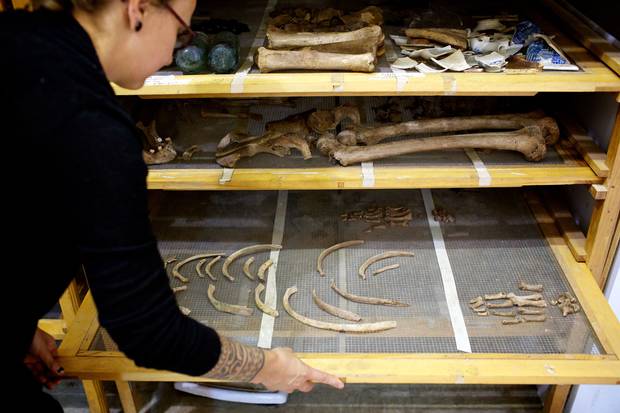
Trays hold the bones of the military man and other items from the cemetery.
MONTREAL'S PAST: MORE FROM THE GLOBE AND MAIL



